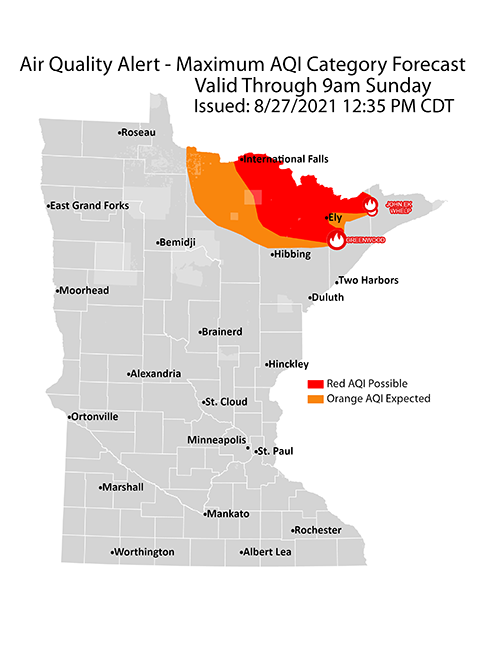Air quality alert continues for northeast Minnesota, valid until 9 a.m. on Sunday
The Minnesota Pollution Control Agency (MPCA) has issued an air quality alert effective until 9 a.m. on Sunday, Aug. 29, for St. Louis, Carlton, Itasca, Koochiching, and Lake Counties. The affected area includes Ely, Virginia, Hibbing, International Falls, Hoyt Lakes, Babbitt, Isabella, and the tribal Nations of Leech Lake and Red Lake. The Greenwood fire continues to burn in the Superior National Forest in northeast Minnesota. The fire is located near Greenwood Lake, or approximately 15 miles southwest of Isabella. The fire is estimated to be 26,000 acres with no containment. While significant fire growth is not expected on Friday and Saturday, the fire will continue producing smoke within the existing fire perimeter. Also, additional smoke will be produced during fire suppression activities. In addition to the Greenwood fire, fires just across the border in the Canadian Quetico Provincial Park continue to burn with no containment and will also contribute to smoke concentrations. East to southeast winds throughout Friday and Saturday are expected to carry the smoke to the west and northwest of the fires. Precipitation arriving Friday and Saturday may temporarily reduce the fine particle concentration to below alert level in most areas. Fine particle levels may reach the Red AQI category, a level that is considered unhealthy for everyone. Red AQI conditions may occur Friday and Saturday in areas downwind and in closer proximity to the fire. Sensitive groups whose health is affected by unhealthy air quality: There are people who are more likely to be affected when fine particle pollution reaches an unhealthy level.
Health effects: Air pollution can aggravate heart and cardiovascular disease as well as lung diseases like asthma and COPD. When the air quality is unhealthy, people with these conditions may experience symptoms like chest pain, shortness of breath, wheezing, coughing, or fatigue. If you are experiencing any of these symptoms, use your inhalers as directed and contact your health care provider. In areas where air quality is in the Red (Unhealthy) AQI category, sensitive individuals may experience increased aggravation of heart or lung disease and respiratory conditions. The general population may also experience increased respiratory effects. In areas where air quality is in the Orange (Unhealthy for Sensitive Groups) AQI category, sensitive individuals may experience aggravation of heart or lung disease and increasing likelihood of respiratory conditions. Take precautions: Everyone should take precautions when the air quality is unhealthy.
In areas where air quality is in the Red (Unhealthy) AQI category, sensitive individuals should avoid prolonged exertion. Everyone else should limit prolonged exertion. In areas where air quality is in the Orange (Unhealthy for Sensitive Groups) AQI category, sensitive individuals should limit prolonged exertion. Pollution reduction tips: The main sources of fine particle pollution is any activity that uses fuel. Conserving energy and buying clean, renewable energy are great lifestyle choices to help reduce overall pollution.
For information on current air quality conditions in your area and to sign up for daily air quality forecasts and alert notifications by email, text message, phone, or the Minnesota Air mobile app, visit MPCA's Air Quality Index webpage. You can find additional information about health and indoor and outdoor air quality at Air Quality and Health webpage. |
Friday, August 27, 2021
Air quality alert issued for Central/Northern St. Louis, Lake and Cook counties until 3 p.m. on Wed., Aug. 25
Subscribe to:
Post Comments (Atom)



No comments:
Post a Comment